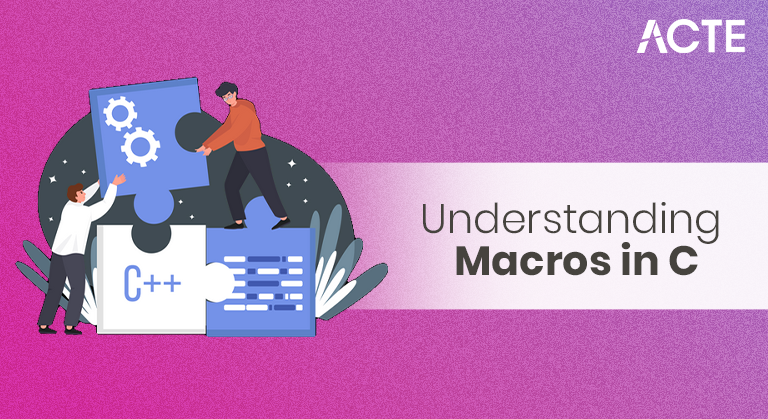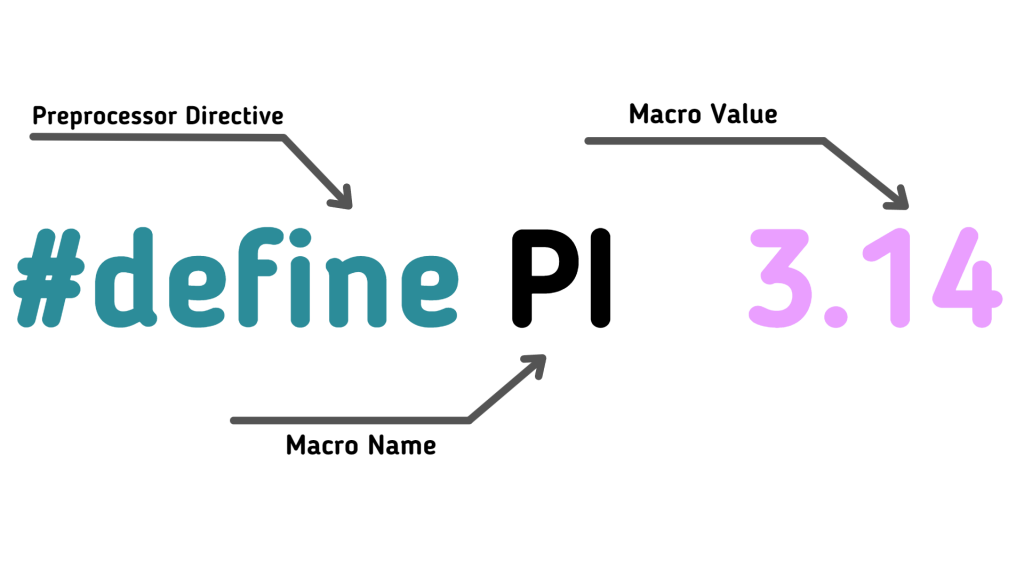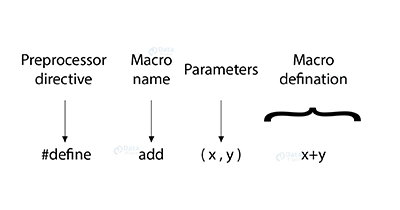
- Introduction to Macros
- #define and Its Uses
- Function-like Macros
- Conditional Compilation
- Macros vs Functions
- Nested Macros
- Scope and Side Effects
- Conclusion
Introduction to Macros
Macros in C are preprocessor directives that provide a powerful way to define constants and reusable code blocks. Introduced with the #define directive, macros allow programmers to simplify code, avoid redundancy, and enhance performance by eliminating function calls. The preprocessor evaluates these macros before the actual compilation process, substituting macro names with their corresponding values or code snippets. his can improve execution speed but may introduce complexity if not managed properly. Macros are widely used in embedded systems, large-scale software projects, and performance-sensitive applications where efficiency is critical. Macros in C are powerful tools provided by the C preprocessor that allow programmers to define symbolic names or code snippets to be replaced before the actual compilation process begins Cloud Computing Training. The most common way to create a macro is using the #define directive. Macros help make code more readable, maintainable, and reusable by replacing repetitive code or constants with meaningful names. There are two main types of macros: object-like macros and function-like macros. Object-like macros act like constants, replacing a name with a value or expression, for example, #define PI 3.14. Function-like macros resemble functions but are expanded inline during preprocessing, which can improve performance by avoiding function call overhead. For example, #define SQUARE(x) ((x) * (x)) calculates the square of a number. Macros also support conditional compilation, enabling different code to compile based on certain conditions, making programs more portable and adaptable. Despite their advantages, macros come with caveats. They lack type checking, can cause unexpected side effects Reverse a String , and debugging them can be challenging. Understanding the difference between macros and functions, especially in terms of scope and side effects, is crucial for effective usage. Overall, macros remain a vital part of C programming, offering flexibility and efficiency when used carefully.
To Earn Your Cloud Computing Course Certification, Gain Insights From Leading Cloud Computing Experts And Advance Your Career With ACTE’s Cloud Computing Course Today!
#define and Its Uses
- #define is a preprocessor directive used to create macros.
- It defines constant values or code snippets that get replaced before compilation. Commonly used to define constants, e.g., #define PI 3.14.
- Helps improve code readability by giving meaningful names to values Software Developer vs Software Engineer .
- Can create function-like macros for inline code expansion, e.g., #define SQUARE(x) ((x) * (x)).
- Enables conditional compilation with related directives like #ifdef.
- Reduces code duplication and makes maintenance easier.
- Macros defined with #define do not consume memory unlike variables.
- Can lead to hard-to-debug errors if not used carefully due to textual substitution.
- Essential for platform-specific code or configuration settings.

Function-like Macros
Function-like macros in C are macros that resemble functions but are expanded inline by the preprocessor before compilation. They are defined using the #define directive followed by a macro name and parentheses containing parameters, like this: #define MACRO_NAME(params) code. Unlike regular functions, function-like macros do not incur the overhead of a function call because their code replaces the macro invocation directly in the source code. This can lead to performance improvements, especially in small or frequently called routines. IT Engineer Salary in India For example, a simple macro to calculate the square of a number can be defined as: #define SQUARE(x) ((x) * (x)) When SQUARE(5) is used, the preprocessor replaces it with ((5) * (5)). However, function-like macros have limitations. They perform textual substitution, so operators and arguments are not type-checked, which can cause unexpected behaviors or side effects, especially if arguments have expressions with side effects (like SQUARE(i++)). Also, macros lack scope, so they do not behave like normal functions in terms of variable visibility and lifetime. Because of these issues, modern C programming often favors inline functions where available, which provide the benefits of macros but with type safety and better debugging support. Still, function-like macros remain useful for simple, performance-critical operations or conditional compilation.
Conditional Compilation
- Macros enable conditional compilation, which allows selective inclusion or exclusion of code blocks based on certain conditions.
- Directives like #ifdef, #ifndef, #if, #else, #elif, and #endif allow developers to compile code differently depending on the presence or absence of certain macro definitions.
- This is particularly useful for writing portable code that must run on multiple platforms, as developers can include or exclude code based on operating system Best Software Development Courses , compiler version, or hardware architecture.
- Conditional compilation also helps in debugging by enabling or disabling logging or test features without modifying the source logic.
- Macros are handled by the preprocessor and replaced directly in code before compilation; functions are compiled and called at runtime.
- Macros perform textual substitution with no type checking; functions have type safety and perform parameter type checking.
- Macros can operate on any Cloud Computing Training data type but can cause unexpected side effects if arguments have expressions with side effects (e.g., i++).
- Functions have a defined scope and support recursion; macros do not have scope and cannot be recursive.
- Macros do not incur function call overhead; functions may have overhead unless declared inline.
- Macros can lead to hard-to-debug errors Become an IT Engineer because errors point to expanded code; functions provide clearer error messages.
- Functions support debugging and profiling; macros do not.
- Macros can manipulate code and perform conditional compilation; functions cannot.
- Use macros for simple, repetitive code snippets or compile-time decisions; use functions for type safety and complex logic.
- When macros accept arguments, they become even more flexible. These are particularly useful for creating parameterized expressions, Complete Guide on System Software such as mathematical operations or conditional checks.
- However, improper use of arguments can lead to errors during expansion. For instance, #define MAX(a,b) ((a) > (b) ? (a) : (b)) compares two values and returns the greater one.
- While powerful, such macros can misbehave if arguments include side-effecting operations like i++, as the macro may evaluate them multiple times.
- Therefore, developers must test such macros thoroughly to prevent bugs.
- Macros have no scope; they are expanded everywhere after definition until undefined or redefined.
- Unlike functions, macros do not respect variable scope rules and can cause naming conflicts.
- Macros perform textual substitution, so variables inside macros may unintentionally clash with variables in the code.
- Side effects occur when macro arguments have expressions with side effects (e.g., i++), causing the expression to be evaluated multiple times What is Software Engineering.
- Example: #define SQUARE(x) ((x) * (x)) with SQUARE(i++) increments i twice, which is usually unintended.
- Side effects make macros error-prone and hard to debug.
- To avoid side effects, use inline functions or ensure macro arguments are safe expressions without side effects.
- Macros do not perform type checking or enforce evaluation order, increasing the risk of unexpected behavior.
- Understanding these limitations is critical for safe and predictable macro usage.
Gain Your Master’s Certification in Cloud Computing by Enrolling in Our Cloud Computing Master Program Training Course Now!
Macros vs Functions

Macros with Arguments
Are You Interested in Learning More About Cloud Computing Course? Sign Up For Our Cloud Computing Course Today!
Nested Macros
Macros can be nested, meaning one macro can call or reference another. This adds complexity but can be useful in advanced configurations. For instance, a configuration macro may expand into multiple smaller macros, which in turn define specific behavior based on build options or target environments. However, excessive nesting can reduce code clarity and increase the likelihood of preprocessor errors. It’s essential to document nested macros well and use them judiciously to maintain code readability and debuggability. Nested macros in C occur when one macro expands into another macro, enabling multiple levels of macro substitution during preprocessing.This technique allows programmers to build more complex or modular code snippets by combining simpler macros Software Engineering Prototype . For example, an outer macro can invoke inner macros to perform parts of a task, making the code more organized and reusable. When the preprocessor processes nested macros, it expands the outer macro first, then continues expanding any macros within the replacement text until no macros remain. While this feature increases flexibility, nested macros can also introduce complexity and reduce code readability, making debugging more challenging because the code seen by the compiler differs from the original source. Additionally, since macros perform purely textual substitution without type checking or awareness of scope, improper use of nested macros may lead to unexpected side effects or errors, especially if arguments are reused or involve expressions with side effects. To minimize such risks, developers should keep macros simple and well-documented, using nested macros sparingly. For more complex operations, inline functions or regular functions often provide better clarity, safety, and maintainability. Overall, nested macros can be a useful tool in C programming but require careful and thoughtful application.
Scope and Side Effects
Preparing for Cloud Computing Job Interviews? Have a Look at Our Blog on Cloud Computing Interview Questions and Answers To Ace Your Interview!
Conclusion
Macros are a powerful yet double-edged feature of the C programming language. When used thoughtfully, they simplify development, enhance performance, and support code reuse. However, their misuse can lead to bugs, obscure logic, and maintenance headaches. Mastering macros involves understanding their mechanics, recognizing their limitations, and applying best practices. As modern compilers and IDEs improve support for alternatives like inline functions and templates, macros remain an essential tool in the C programmer’s arsenal, especially in performance-critical and system-level programming. Macros in C are a versatile Cloud Computing Training and powerful feature that allow programmers to write more flexible and efficient code. By using #define, function-like macros, and conditional compilation, developers can simplify repetitive tasks, improve code readability, and tailor compilation to different environments. However, macros come with limitations such as the lack of type safety and potential side effects, which require careful usage and understanding. Knowing when to use macros versus functions is key to writing clean and maintainable code. Mastering macros empowers C programmers to harness the full potential of the language’s preprocessor and build more robust applications.





